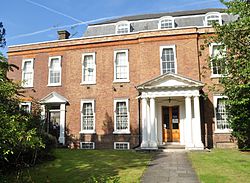123 Mortlake High Street
| 123 Mortlake High Street | |
|---|---|
 | |
 | |
| General information | |
| Type | Residential, but converted for office use |
| Architectural style | Georgian |
| Location | Mortlake High Street, London SW14, England |
| Coordinates | 51°28′13″N 0°15′27″W / 51.4704°N 0.2574°W |
| Construction started | c. 1720 |
Listed Building – Grade II* | |
| Official name | Limes House and Forecourt Piers |
| Designated | 25 October 1951 |
| Reference no. | 1065428 |
123 Mortlake High Street, also known as The Limes or Limes House and previously referred to as Mortlake Terrace,[1] is a Grade II* listed[2] 18th-century property on Mortlake High Street in Mortlake in the London Borough of Richmond upon Thames. The building is now used as commercial office space. It was originally a private house and in the 20th century it functioned as the local town hall. It is featured in two paintings by J. M. W. Turner.
History of the building[edit]

The house was built in about 1720 but the facade and porch were added later.[3] The design involved a symmetrical main frontage with nine bays: the central section features a porch with four Tuscan columns.[4]
The building was the seat of local government for the Barnes Urban District from 1895 to 1932[5] and then of the Municipal Borough of Barnes from 1932 until 1940, when it was damaged by wartime bombing.[3]
The house's 7 acres (2.8 ha) of grounds have now been completely built over, and the building itself has been converted to commercial office space. The exterior is still similar to what it was in two oil paintings that J. M. W. Turner (1755–1851) made while visiting the house in 1827.[3]
Artistic depictions[edit]
Turner's two paintings were made for William Moffatt,[1][6] whose house it then was. Mortlake Terrace: Early Summer Morning (1826) is in the Frick Collection, New York.[1][3] It was shown in the Royal Academy exhibition of 1826 where it was praised for its "lightness and simplicity".[1] Mortlake Terrace (1827) is in the National Gallery of Art, Washington D.C.[1][6]
The Museum of London holds a wood engraving of people at The Limes, as it was then called, watching the Oxford and Cambridge Boat Race. The Limes – Mortlake: 1872 is taken from London: A Pilgrimage by Blanchard Jerrold and Gustave Doré, 1872. Jerrold describes how "the towing paths presented to the view of the more fortunate people upon the private river-side terraces, a mixed population ..."[7] The house was, at the time, the residence of a Mr Marsh Nelson.[8]
Former residents[edit]
The house's former residents include the Franks, a family of Jewish merchant bankers;[9] Lady Byron, widow of the poet; the educational philanthropist Quintin Hogg;[3] and Garnet Wolseley, 1st Viscount Wolseley,[10] who lived there from 1874 to 1875[11] and later became Commander-in-Chief of the Forces.[12]
References[edit]
- ^ a b c d e "Joseph Mallord William Turner (1775–1851) Mortlake Terrace: Early Summer Morning, 1826". Frick Collection, New York City. Archived from the original on 30 September 2013. Retrieved 30 September 2013.
- ^ Historic England (25 October 1951). "Limes House and Forecourt Piers (1065428)". National Heritage List for England. Retrieved 17 July 2020.
- ^ a b c d e "The Limes". Barnes and Mortlake History Society. Retrieved 30 September 2013.
- ^ Bridget Cherry & Nikolaus Pevsner (1983). The Buildings of England – London 2: South. London: Penguin Books. p. 513. ISBN 0-14-0710-47-7.
- ^ "No. 33844". The London Gazette (Supplement). 8 July 1932. p. 4453.
- ^ a b "Mortlake Terrace 1827". National Gallery of Art, Washington D.C. Retrieved 16 January 2021.
- ^ "The Limes – Mortlake: 1872". Museum of London. Archived from the original on 3 December 2013. Retrieved 30 September 2013.
- ^ Gustave Doré & Blanchard Jerrold (1872). "London: A pilgrimage". Chapter VI. Victorian London. Retrieved 1 October 2013.
- ^ Malcolm Brown (1982). "Anglo-Jewish country houses from the Resettlement to 1800". Transactions & Miscellanies (Jewish Historical Society of England). 28: 20–38. JSTOR 29778917.
- ^ Ben Weinreb; Christopher Hibbert; John Keay & Julia Keay (2008). The London Encyclopaedia (Third ed.). Macmillan. p. 485. ISBN 978-1-4050-4925-2.
- ^ "People of Mortlake, Barnes and East Sheen: T-Z" (PDF). Barnes and Mortlake History Society. Retrieved 13 May 2021.
- ^ "No. 26676". The London Gazette. 1 November 1895. p. 5923.


